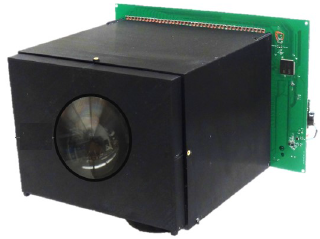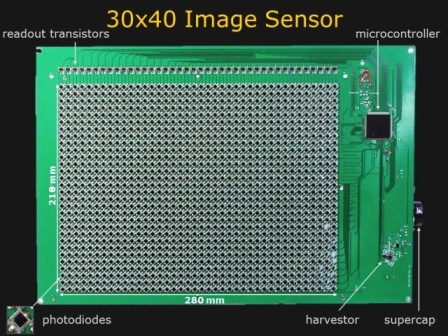A video camera that powers itself
April 15, 2015

The complete self-powered camera system with sensor array powered by supercapacitor recharged using just energy harvested from pixels (credit: Columbia University)
A prototype self-powered video camera that can produce an image every second of a well-lit indoor scene has been invented by a research team led by Shree K. Nayar, T.C. Chang Professor of Computer Science at Columbia Engineering.
“We are in the middle of a digital imaging revolution,” says Nayar, who directs the Computer Vision Laboratory at Columbia Engineering. “A camera that can function as an untethered device forever — without any external power supply — would be incredibly useful.”

The prototype sensor array has 30×40 photodiodes (1200 pixels). On the front of the board are photodiodes, readout transistors (top,) and microcontroller (right). On the back of the circuit board is an array of two-switch packages, each including the two transistors used in the corresponding pixel. The back also includes global reset and harvest switches and harvesting power supply. A supercapacitor (right) is charged to start the camera but after that, is recharged using only energy harvested from the pixels. (credit: Columbia Vision Laboratory/Columbia Engineering)
A leading researcher in computational imaging, Nayar realized that although digital cameras and solar panels have different purposes — one measures light while the other converts light to power — both are constructed from essentially the same components. At the heart of any digital camera is an image sensor, a chip with millions of pixels.
The key enabling device in a pixel is the photodiode, which produces an electric current when exposed to light. That enables each pixel to measure the intensity of light falling on it. But note that the same photodiode is also used in solar panels to convert incident light to electric power. Could these functions be combined?
That’s exactly what Nayar did, using standard off-the-shelf components to fabricate an experimental image sensor with just 30×40 pixels. In photoconductive mode, the photodiode is used to sense a pixel, while in the photovoltaic mode, it is used to generate electricity to power the camera.
How it works
The design is simple: it uses just two transistors per pixel. During each image capture cycle, the pixels are used first to record and read out the image and then used to harvest energy and charge the sensor’s power supply. When the camera is not used to capture images, it can be used to generate power for other devices, such as a phone or a watch.
“A few different designs for image sensors that can harvest energy have been proposed in the past. However, our prototype is the first demonstration of a fully self-powered video camera,” he continues. “And, even though we’ve used off-the-shelf components to demonstrate our design, our sensor architecture easily lends itself to a compact solid-state imaging chip. We believe our results are a significant step forward in developing an entirely new generation of cameras that can function for a very long duration — ideally, forever — without being externally powered.”
He notes that in the last year alone, approximately two billion cameras were sold worldwide. “I think we have just seen the tip of the iceberg. Digital imaging is expected to enable many emerging fields including wearable devices, sensor networks, smart environments, personalized medicine, and the Internet of Things.
The team is presenting its work at the International Conference on Computational Photography at Rice University in Houston, April 24 to 26. The research was funded by Office of Naval Research.
Abstract of Towards Self-Powered Cameras
We propose a simple pixel design, where the pixel’s photodiode can be used to not only measure the incident light level, but also to convert the incident light into electrical energy. A sensor architecture is proposed where, during each image capture cycle, the pixels are used first to record and read out the image and then used to harvest energy and charge the sensors’ power supply. We have conducted several experiments using off-the-shelf discrete components to validate the practical feasibility of our approach. We first developed a single pixel based on our design and used it to physically scan images of scenes. Next, we developed a fully self-powered camera that produces 30×40 images. The camera uses a supercap rather than an external source as its power supply. For a scene that is around 300 lux in brightness, the voltage across the supercap remains well above the minimum needed for the camera to indefinitely produce an image per second. For scenarios where scene brightness may vary dramatically, we present an adaptive algorithm that adjusts the framerate of the camera based on the voltage of the supercap and the brightness of the scene. Finally, we analyze the light gathering and harvesting properties of our design and explain why we believe it could lead to a fully self-powered solid-state image sensor that produces a useful resolution and framerate.
